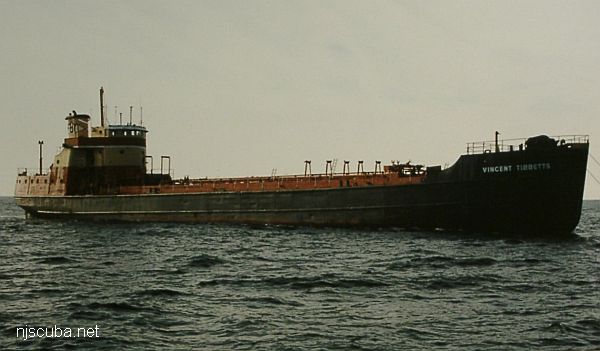April 9, 2021
The Good Old Days
April 9, 2021
While looking over an old hard drive, I found this newspaper article ...
Secrets of the Deep
The Times [Trenton]
01/13/02
By JEFF TRENTLY
Staff Writer
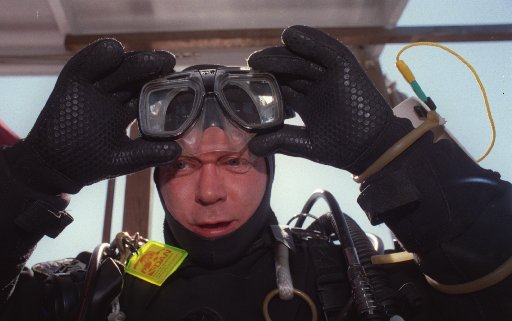
They peel off their shoes, strip off their socks, their shirts, their pants.
They freeze.
They slip on hoods and fins and drysuits, gaze at each other through bubble masks. They plunk on air tanks, wobble like penguins, and gape into the emerald green sea.
They take the giant stride, step off the boat's deck. Into the underworld.
The water parts, becomes flat. Jellyfish dance and glow. Ed Knepshield follows an anchor line; he breathes the air he brings. Weightless, he swims into the gloom.
It is cold and alien. Bubbles burst about his face. He checks his air, shines a light. And hears the clicking of the fish.
Shrimp click. Crustaceans crackle. Blackfish chatter and pop. This is the sound of life 80 feet below the surface.
It echoes, says Ed, "like Rice Krispies going off all over the place."
Ed Knepshield, in dark mask and yellow flippers, pulls himself out of the sea's embrace.
He's dripping, exhausted, excited and numb.
The lobster he's caught -- only his second in 200-some dives -- wriggles in a catch bag hanging from his waist.
Knepshield looks like a space alien in his hooded dive suit and gloves.
He's come back to solid earth from another time, a place 121 years old -- a place that exists only in a lonely water world inhospitable to man, yet a place man created.
Knepshield has come from diving a shipwreck.
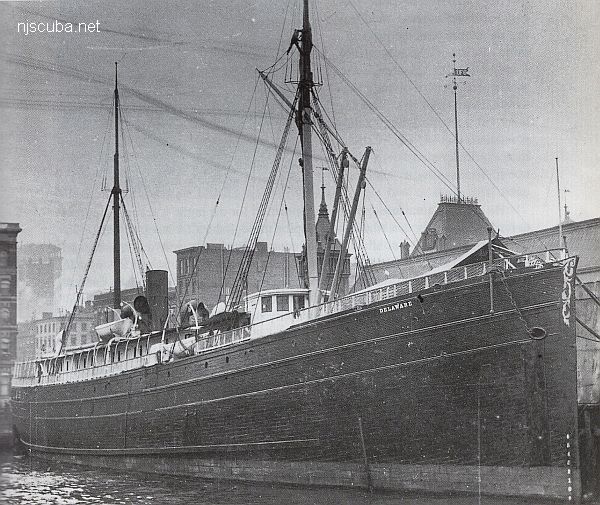
The Delaware sank in July 1898 off the coast of Point Pleasant, one of 4,000 wrecks near the New Jersey Shore.
The ship burned to the waterline; all that's left are wooden ribs that stick up like a skeleton on either side of the engine and a massive, massive propeller shaft.
No one died in this wreck.
No hearts surrendered to the sea.
And yet …
"Something happened here," Knepshield says.
Something. The Delaware weighed 1,600 tons and was 250 feet long. A steamship, she carried both cargo and passengers. Some say she held a large payroll, never recovered; she's listed as a treasure ship.
Down there, where Knepshield dives in the inky blue-green depths, where lobsters lay eggs and lobster larvae emerge -- "thousands of little transparent things swimming all over the place" -- down in the mouth of the wreck, Knepshield finds a strange tranquility.
"The whole thing is ghostly," he says. "It's spooky. And you're flying through this stuff."
Buried in the silty bottom are glassware, china, bottles, pennies, brass spikes, doorknobs, portholes, gold coins.
"Pieces of people's lives," Knepshield says.
Steve Nagiewicz feels the sway of the ocean more than most.
As captain of the Diversion II, he's made 3,000, maybe 4,000 dives (he lost track after 2,500).
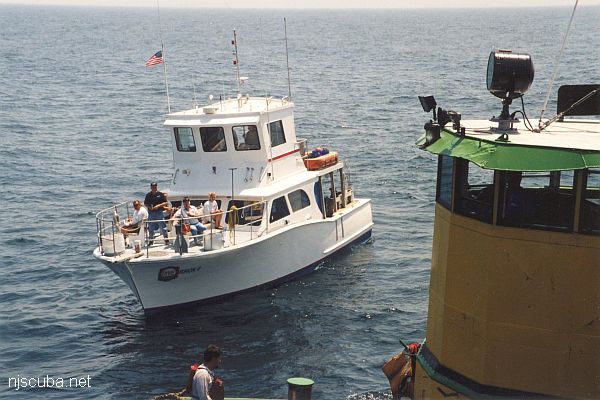
But not today.
Today he's watching the waters.
Up in his wheelhouse, where the pitch and sway of the ocean can be felt most keenly, Captain Steve has reached a sort of seafaring nirvana.
"I find the ocean a calming place," he says. "I come out here and the world doesn't seem to matter."
He's sitting watching divers' air bubbles crash to the surface. An old-style wooden captain's wheel is before him. "If this boat ever sinks, it'll give divers something to find," he says.
Nagiewicz knows all about finding things -- silver bars, crystal inkwells, shoes, pens, cake tappers.
"The artifacts are kind of like a small look into history," he says. "Go back to 1872 and see the bottles they drank from, or the cups or the toys, the utensils they used."
Nagiewicz shifts in his captain's chair. Before him, the boat's radar screen glows green, like the sea. On sonar, traces of the wreck and seafloor are outlined in blues and reds.
Somewhere down there, a half-dozen divers are swimming into a sunken, hidden history.
"I think that's part of the attraction to people," he says. "You're on something that can't be tamed and you're a part of taming it, surviving for the day."
Nagiewicz scratches his gray-flecked beard.
"The danger is always there," he says. "If you panic a mile and a half off the beach, you're just as dead as if you're 1,000 miles."
Marcia Gaddy was just as dead.
Twenty miles offshore. One hundred and thirty feet down.
She was diving the Stolt Dagali, one of the most popular Jersey wrecks. The Stolt was a tanker severed in two in a collision in 1964. Several crew members died.
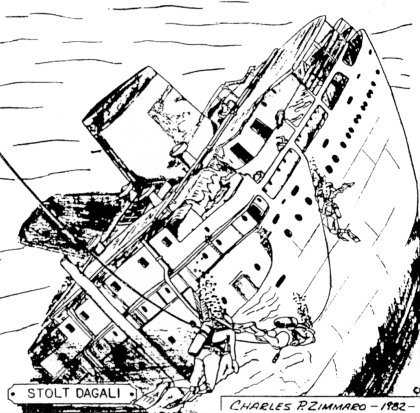
Gaddy was about to be next.
An air embolism -- "just like a soda bottle fizz" -- sent a nitrogen bubble to her brain and spinal cord.
"It left me paralyzed and blind five months ago," she says over the roar of a ship's engine.
It was a tough recovery.
"The Coast Guard delivered me to the hospital DOA. But DOA isn't forever."
She remembers things turning upside down, then she was floating to the light on the ocean's surface, then pulled onto the boat's deck. She could hear her buddies yelling at her to breathe, breathe, but she couldn't see, couldn't speak, couldn't feel.
"The helicopter flight was very bad and I tried to hold the vision of my children in my mind ..."
And then nothing. A white light. A beautiful little girl.
Gaddy smiles, touches the bow's rail. She was married on a boat like this, held a lobster in her hand in place of flowers. She can't dive anymore, but can see and walk.
And can crew a dive boat.
"I still have a lot of problems with my legs," she says, "but I'm seaworthy …"
Ed Knepshield wanted to be seaworthy since he was a little boy watching Lloyd Bridges on "Sea Hunt."
He never was.
Instead, he went to Vietnam, went to college, got married, got divorced, got remarried, spent a lot of years working in administrative analysis -- figures, budgets, spreadsheets, numbers.
No sea.
No adventure.
No Lloyd Bridges.
Then, one day, he was driving by a scuba shop -- he passed the shop every day, two times a day, on his way to and from work -- and something clicked.
Wanna take a dive?
Knepshield made a U-turn and signed up.
That was six years ago. Ed teaches diving now at Lang's Ski N' Scuba -- he's a divemaster and instructor at the Ewing store -- and he's immersed himself in more than seawater.
For Knepshield the administrative analyst, it's the lure of the plunge that keeps him coming back -- "We all have to have adventure in our lives," he says, glasses cocked on his nose.
But it's also a time machine.
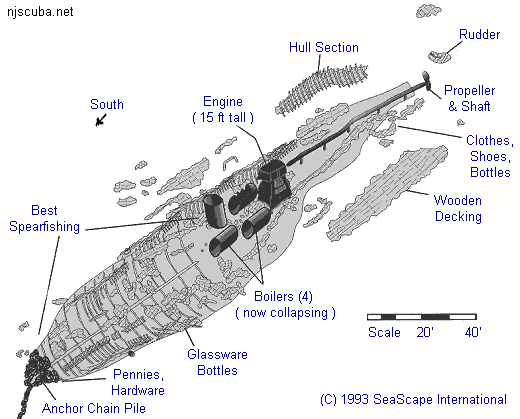
"It's like going into a ruin," he says. "It's like you're an archaeologist. You're exploring these ruins."
What happened on that wreck? he wonders.
"You start thinking about people working on the boat. You start seeing things, like this tiled floor. This was in the kitchen. People walked across this and now it's covered in sea anemones.
"There's the galley doors -- there's people who walked through there …
"A lot of divers lose sight of that, but it's kind of a spooky thing and you have to remember -- people did die here. It's sort of a sacred thing, a solemn thing.
"A lot of divers won't say it, but it's there."
"Oh, we got beasts," the woman in the pink dive suit is saying.
Helen Bilinski, spear in hand, has just emerged from the emerald deep. At 51, the woman spears fish. ("It's not easy," she says. "The fish will look at you.")
Too bad for Helen, the beasts are not hers.
"You didn't see them, Helen?" Rich Galiano says. "They're all over the place. Up in the boilers, around the engine …"
Galiano shows off his catch of the day -- six blackfish, nabbed with a spear.
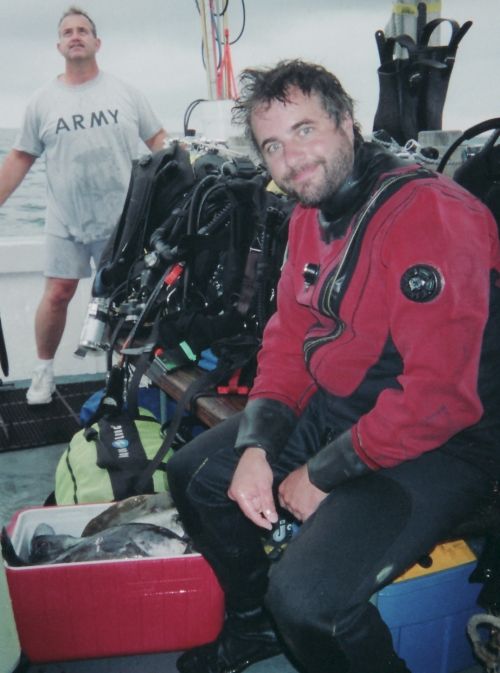
Grocery diving.
"It's more like hunting than fishing, really," he says.
Galiano starts strapping on his scuba gear -- all 169 pounds of it * -- for another dive.
Down there, in the underworld, it weighs nothing -- he weighs nothing.
"This is kind of a select crowd, here, the Northeast divers," Galiano confides behind a bug-eyed mask. "It takes a lot more equipment, a lot more experience."
"We have so much diving jewelry, we're loaded," Bilinski says.
The water temperature? Fifty-five, 60 degrees.
"That's warm for up here," Galiano says.
"You get in here the first time, you've got that dark green water and, gosh, you can only see 20 feet …" **
Galiano stands ready to take the giant stride. He's excited, you can tell. Bouncy, like a little kid. ***
"You got air?" someone asks him.
"Yup."
"That's always a good thing."
"What the heck?" he says. "This isn't like National Geographic."
Editor's notes:
* I have no idea where he got this number. Half that, maybe.
** 20 feet on the Delaware? 10 would be a good day!
*** I don't think I've ever been bouncy like a little kid.
Continued ...
Reflections on the Underworld
01/13/02
"The ocean covers a large part of Earth's surface and guess what? We haven't explored it yet. It really is the last frontier of exploration. It's still a mystery. You're an explorer every time you get into the water. You're getting to do something a minute part of the population will ever get to participate in, and that's like being an astronaut. How many people are gonna get to go to the moon?"
-- Joe Feyti,
store manager who has
made more than 2,000 dives
"The Andrea Doria -- that's what they call the Mount Everest of shipwrecks. That's the one you work your way up to. It's the hardest dive, mainly because of its depth, its climate. The water's cold. It's 100 miles from the closest shore. Many divers who are veterans have lost their lives on it. I've been present when divers have died."
-- Gary Szabo,
Co-Captain of the Seeker
who has been diving 20 years
"You start down the line and you look and you can see the ribs and the skeleton of the whole thing. You're in awe. This sense of well-being comes over you. The man-made structure and the fish swimming around, the growth on it ... It was so serene and it was so quiet it was almost like going into a chapel. It's like you're the only person there. You see man-made structures underwater that aren't supposed to be there. We'd find a shoe that maybe was a part of a passenger's cabinet, or a lamp, or keys. It's like a treasure hunt."
-- Kathi Feyti,
dive instructor who
once dove in a shark rodeo
"I've found bones. It's a little eerie, but it's reality. I've recovered bodies, which is probably much more disturbing than finding a skull or a bone. A skull or a bone is almost -- there's nothing there. But a body that's still intact, that's a little bit more disturbing."
-- Dan Crowell,
Captain of the Seeker
who has made 15,000 dives
"You're just being born again. All your experiences here -- everything you understand and know -- your whole life -- they don't have anything to do with it. It's a completely new world. You see stuff you've never seen before."
-- Bill Yeoman,
electrical contractor who
has been diving seven years
"You're weightless. You're totally weightless and it's a really strange thing. You're expecting yourself to land and you're not. You're floating away."
-- Ed Knepshield,
administrative analyst who
has made more than 200 dives
"Reef sharks -- they're here, but you don't see them. Which is probably just as well. It freaks people out if you can see 'em."
-- Steve Nagiewicz,
Captain of the Diversion II
who has been diving for 30 years
"Worst part about the dive? Coming to the surface."
-- Lauren Ruthrauff,
teacher who has been
diving nine for years
images added by editor

